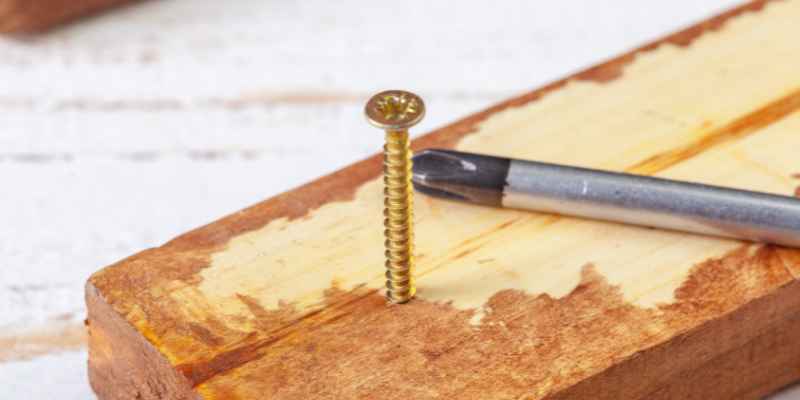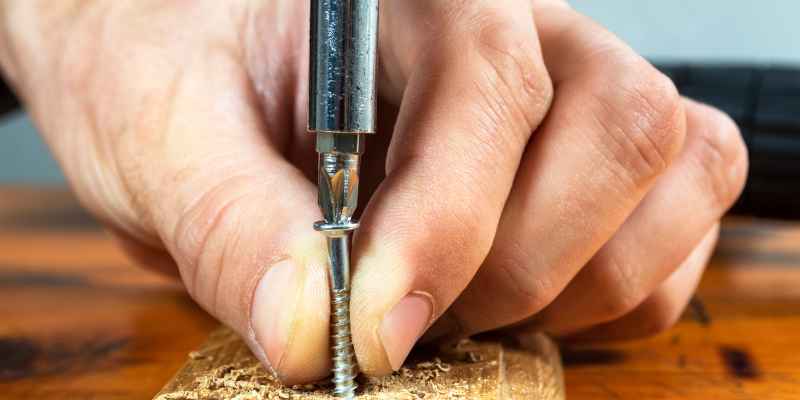A screw should go at least half-way into the securing material. When screwing into wood, it’s important to ensure that the depth of the screw is appropriate for the material being used.
Using a screw that is too long may result in splitting or damage to the wood, while using one that is too short may not provide a secure enough hold. To avoid these issues, it’s important to choose the correct size and length of screw for the task at hand.
We will explore the various factors to consider when determining the appropriate screw length for different types of wood and applications. We’ll also discuss tips for driving screws without splitting the wood and common mistakes to avoid when using screws in woodworking projects.
Determining The Appropriate Screw Length
When determining the appropriate screw length for wood, it is recommended that the screw should go at least halfway into the securing material, or about two-thirds of the length of the screw should penetrate into the lower piece. It’s also essential to consider the type of forces against the screws, drill pilot holes and avoid screws that are too long or too short to prevent splitting.
When it comes to woodworking, knowing the proper screw length is essential to ensure the joints are strong, secure, and long-lasting. The right screw length should be long enough to hold the pieces together without breaking the surface or causing any splitting. However, it should not be so long that it protrudes out of the other side of the wood, or it may be unsightly or even dangerous in some cases.
Factors to Consider
Before choosing the right screw length, there are some factors to consider. These include the thickness of the wood, the type of wood, the screw size, and the intended use of the joint. For thicker wood, longer screws are needed to penetrate deep enough to hold the joint securely. Softwood requires shorter screws than hardwood because it is not as dense. The screw size should also be appropriate for the intended use, with larger screws being used for heavier loads.
Screw Length Rule of Thumb
The general rule of thumb is to use a screw that is at least twice the thickness of the material being fastened. For example, if the joint involves two pieces of 1-inch thick wood, use a screw with a length of at least 2 inches. However, this rule may not always apply, and it’s essential to take into account the other factors mentioned above.
Other Considerations
Aside from the thickness of the wood, there are other considerations when choosing the appropriate screw length. If the screw runs perpendicular to the grain of the wood, it should not be too long, or it could split the wood. On the other hand, if the screw runs parallel to the grain, it can be longer without causing splitting. Additionally, screws used for drywall have their own specific length requirements, and screws used in areas subjected to shear forces should also be selected carefully.
In conclusion, choosing the appropriate screw length is crucial for a secure and sturdy joint. Always consider the thickness of the wood, the type of wood, and the intended use of the joint when selecting the screw length. Remember the rule of thumb of using a screw that is at least twice the thickness of the material being fastened, but also take into account other factors that may affect the strength and stability of the joint.

Attaching Screws To Different Types Of Material
The length of a wood screw should be at least two thirds of the length of the material being fastened, but it should not go all the way through. It’s recommended to use the correct screw length for drywall, cross-grain, end grain, and different types of forces against screws.
Additionally, drilling pilot holes, countersinking, and avoiding splitting wood can also help with attaching screws to different types of material.
When working with wood, it’s important to know the correct length of screws needed for proper attachment. The length of a screw should always be slightly longer than the thickness of the material being fastened so that it can bite into the wood for a secure hold. However, different types of materials require different screw lengths for optimal attachment.
Correct Screw Length For Drywall
Drywall is a fragile material that can easily crack or break if the wrong screw is used. To avoid this, use a screw that is no longer than the thickness of the drywall and will not penetrate into the stud behind it. A common length for drywall screws is 1 ¼ inches. This size will ensure that the screw grips the drywall securely without breaking through.
Attaching End Grain
When attaching end grain, such as the end of a board or the edge of a panel, screws should be at least twice the thickness of the material. For example, if the material being fastened is ¾ inches thick, the screw should be at least 1 ½ inches long. This will provide a strong enough grip to prevent the material from loosening over time.
Other Considerations
Aside from material thickness, there are other factors to consider when determining the correct screw length for a job. These include the type of force that will be acting on the screw, such as shear force or tension, and whether or not the screw will be countersunk. It’s important to take all of these factors into account in order to ensure a secure and stable hold.
In conclusion, the length of a screw is an important factor to consider when attaching screws to different types of material. Always choose screws that are slightly longer than the thickness of the material to ensure a secure hold. Consider the type of force acting on the screw and whether or not it will be countersunk to determine the appropriate screw length for the job.
Avoiding Splitting Woods
To avoid splitting wood when driving a screw, it’s important to choose the correct length and also to drill a pilot hole. As a general rule, the screw should penetrate at least two-thirds of the length of the bottom piece of wood.
It’s also important to consider the type of force that will be exerted on the screw and choose the appropriate screw type.
Pilot Holes
To avoid splitting woods, it is recommended to drill pilot holes before driving screws. Pilot holes are small holes drilled into the wood where the screw will be inserted. This will prevent the wood from cracking or splitting when the screw is inserted. The diameter of the pilot hole should be slightly smaller than the screw’s outer diameter. For hardwoods, the pilot hole’s diameter should be slightly smaller than the screw’s shank diameter.
Countersinking Screws
Countersinking screws is another technique to avoid splitting woods. This involves drilling a larger hole on the wood’s surface where the screw head will be inserted. This allows the screw head to sit below the wood surface, creating a flat surface and preventing the wood from splitting. After drilling the pilot hole, use a countersink bit to create the larger hole.
Correct Screw Length For Drywall
The correct screw length for drywall is 1 ¼ inches. The screw should go through the drywall and into the wall stud. If the screw is too short, it won’t hold the weight of the object, and if it’s too long, it will damage the wall.
Other Considerations
When screwing into wood, it’s important to consider the wood’s thickness, hardness, and the screw’s type and size. It’s also important to ensure that the screw’s threads match the wood’s grain direction. For softwoods, use coarse threads, and for hardwoods, use fine threads. If you’re unsure about the correct screw length or size, consult a woodworking guide or a professional.
Determining Screw Length For Specific Woodworking Projects
Determining the right screw length for specific woodworking projects is crucial. Typically, a screw should penetrate at least two-thirds of the length of the piece being fastened to ensure a secure hold. It is important to consider the thickness of the material being fastened, the orientation of the screw, and the type of force the joint will experience.
How Far Should A Screw Go Into A Stud?
When installing items onto a wall stud, you want to ensure that the screw goes deep enough into the stud to hold the weight of the item securely. The rule of thumb is that the screw should go into the stud at least one inch or the thickness of the item, whichever is greater. This will ensure that the screw holds the item securely in place without the risk of it coming loose.
Depth Of Screws For Woodworking Projects
When choosing the correct screw length for woodworking projects, it is essential to consider the thickness of the wood you are using. A general rule of thumb is to use a screw that is at least twice the thickness of the wood you are fastening, but not too long that it splits the wood.
For softwoods, such as pine or spruce, a screw that is 1 1/2 inches long may be sufficient, but for hardwoods, such as oak or maple, a screw that is at least 2 inches long may be necessary.
Screw Length For Bookcases
When attaching a bookcase to a wall, you need to ensure that the screw goes deep enough into the wall to hold the weight of the bookcase and its contents. It is recommended to use screws that are at least 2 1/2 inches long, going through the bookcase frame and into the wall stud. If your bookcase has a back panel, you will need to factor this into the screw length calculation.
Overall, it is crucial to choose the correct screw length for your woodworking projects to ensure that they are sturdy and secure. By considering the thickness of the wood and the weight of the item you are fastening, you can determine the appropriate length for your screws. If you are unsure, it is always better to err on the side of caution and use a slightly longer screw rather than risking instability and damage to your project.
Understanding Types Of Forces Against Screws
To determine how deep a screw should go into wood, it’s important to understand the type of forces against screws such as shear force and tension force. The rule of thumb is to go at least halfway into the securing material, however, if in doubt, always consult a professional to avoid splitting the wood.
When it comes to fastening wood with screws, knowing how far the screw should go into the wood is crucial. If the screw is too shallow, it might not hold the weight it is expected, and if it’s too deep, the wood might split, which might compromise the strength of the connection. However, beyond how far the screw should go into wood, it’s also essential to understand the various types of forces against screws when in use.
Shear Force
Shear force is one of the most common types of forces against screws. The force occurs when the load is applied parallel to the joint’s plane, causing the screws to try to bend outward, resulting in breaking the joint apart. This force commonly occurs when fastening materials that undergo tension or compression, such as bed frames, door hinges, and table legs.
To prevent shear force, it’s critical to align the screw with the grain of the wood and avoid over torquing the screws. It’s also vital to ensure the screw length is adequate to provide enough support to hold the force when it occurs.
Tension Force
Tension force results when an object stretches a joint in the opposite direction, causing the screws to pull out from the wood. This force occurs when fastening items such as curtains and wall-hangings or when hanging heavy shelves.
To secure against tension force, use longer or thicker screws or add an anchor that spreads the load over a more extensive area. Anchors work well on drywall, where the material might not be strong enough to hold the screw on its own.
Conclusion
In woodworking, understanding the various types of forces against screws is essential in ensuring the connection remains strong and durable. Whatever type of force against screws you are dealing with, it is vital to use the right combination of screw length, thickness, and diameter to ensure that the joint remains securely in place.
Choosing The Correct Screw Length And Depth
To ensure a secure and strong assembly, it is essential to choose the correct screw length and depth when fastening wood. As a general rule, the screw should penetrate the lower piece by about two-thirds of its length, with enough depth to provide a strong connection without splitting the wood.
It is crucial to consider the type of wood, screw size, and resistance forces when selecting the correct screw length and depth for your woodworking projects.

Screw Length And Load On The Components
The length of screws used in woodwork is a crucial aspect that should not be ignored. Choosing screws that are too long or too short can lead to a compromised joint that is not durable or strong enough to hold the load that will be put on it. The rule of thumb is that the screw should go at least halfway through the securing material for the connection to be strong enough.
Lag Screws Vs. Wood Screws
When it comes to choosing between lag screws and wood screws, there are a few things to consider. Lag screws are thicker and have a hex-headed shape that allows them to hold loads much better and to resist pull-out. Wood screws are thinner and have a tapered shaft that allows them to get a better grip on the wood, but they may not be sufficient for certain jobs, especially when holding heavy loads.
Screw Length Rule Of Thumb
As mentioned earlier, the screw should go at least halfway through the securing material. This means that a 3/4 inch thick wood piece would require a screw of 1-1/2 inches length. For thicker pieces of wood, the screw length should increase accordingly.
Other Considerations
It’s essential to keep in mind that screws should be driven straight into the wood to prevent splitting. For cross-grain connections, pre-drilling a pilot hole is recommended to avoid splintering or cracking. Additionally, it’s essential to match the screw size and type to the project requirements.
Types Of Forces Against Screws
When choosing the screw length, it’s crucial to consider the types of forces that the joint will face. For example, a joint that will be exposed to shear forces will require screws that are long enough to resist pull-out. On the other hand, a joint that will be primarily exposed to tensile forces will require screws that are thick enough to resist breaking.
In conclusion, choosing the correct screw length and depth is essential for creating a durable and strong joint that can withstand the load put on it. It’s important to consider the types of forces that the joint will face, the material being used, and the type and size of screw required. By ensuring that you have the right screw for the job, you can complete your woodworking projects with confidence.
Frequently Asked Questions Of How Far Should A Screw Go Into Wood
How Deep Should A Wood Screw Go Into Wood?
A wood screw should go at least half the depth into the material being fastened. It’s essential for secure holding.
How Deep Should A Screw Go Into Wood Shelf?
For a wood shelf, the screw should go at least halfway into the securing material. It is recommended to use a screw length that is two-thirds the length of the wood being fastened to ensure a secure connection without splitting or damaging the wood.
How Far Should Screw Go Into 2×4?
For a 2×4, a screw should go at least half of its length into the wood. It is advisable to pre-drill holes for screws before fastening them to avoid splitting the wood. Ensure that the screw is not too long or too short for the job to prevent weakening the wood.
How Far Should A Screw Go Into A Stud?
When installing a screw into a stud, aim to go at least halfway into the stud. Additionally, prevent the screw from going too deep by ensuring its length is appropriate for the thickness of the material you are fastening. It’s not advisable to go all the way through the material.
Conclusion
The right screw length depends on various factors, including the type of wood and the thickness of the materials being attached. It is important to select the correct screw length to avoid splitting, damage, and ensure a secure and durable connection.
Always remember to drill pilot holes, avoid using screws that are too long or too short, and select the appropriate screw length and type for the project at hand. Following these guidelines will ensure successful and long-lasting woodworking projects.


